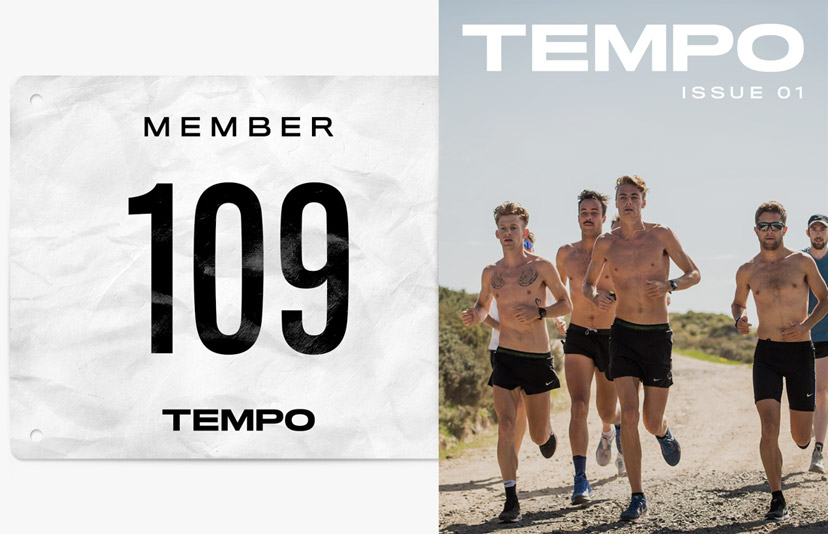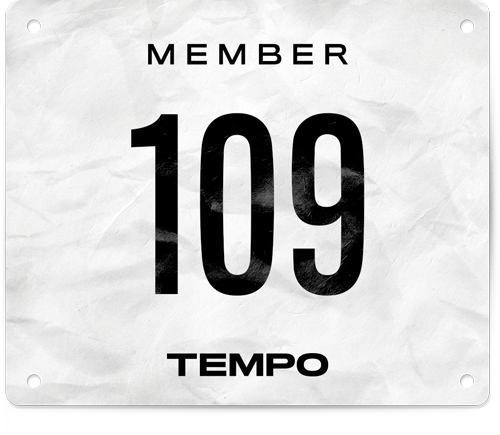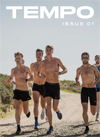Lifestyle
Design on the Run
Pushing the boundaries of running convention with Erick Goto
Erick Goto is an exceptionally talented designer with a large body of work created for Nike Basketball.
His fingerprints can be found on projects for athletes like Kobe Bryant, Lebron James, Kevin Durant, and Kyrie Irving. Most recently, Goto has worked as a design director for Nike Running focusing on special projects.
Erick also co-founded Portland based run crew Run Trill, a crew made up entirely of Nike creatives.
TEMPO Creative Director Andy Sargent (of SouthSouthWest) counts Erick as a close friend and occasional colleague, and when the two caught up for lunch in Melbourne recently, we simply had to mic them up.
Below is a lightly edited transcript of the conversation.
Welcome to Melbourne. Its been a while, what’s been happening with you, career wise?
I actually just hit my 10 year mark at the company in June. I did about 8.5 years in performance basketball doing graphics and product collections, working with athletes, that kind of stuff. Then the opportunity came up to join performance running and do a similar kind of thing, which was cool because running shoes at Nike have historically been some of the most iconic pieces in the brand’s history. It was a category I’d had on my bucket list, for sure.
My work that people had seen until that point had focused mostly on storytelling through graphic or colour way based over that 9 year span, but over that amount of time you learn a lot about industrial design and construction and materials. You can’t not learn that stuff when you’re applying graphics and colours and materials.
As a designer, I’ve always been into exploring and working in different mediums, and this new job really reinvigorated me.
That’s quite a leap from Basketball to Running, how have you found it?
I think the shift to the Running category unlocked a lot for myself creatively and personally. I started mostly re-assessing where Nike Running was with “packs” of shoes and making a conscious effort to evolve what storytelling meant to footwear.
My first official project that I took on from the bottom up as Design Director was the Zoom Fly SP. Nike wanted to do something around Breaking2 but they wanted an energy piece to use for the exclusive “tier 0” space (think NikeLab).
So where in basketball I was curating athlete stories through graphics and veneering, here I was doing storytelling through innovation. It was about the science of running. It was about the authentic way we build shoes for runners.
It’s cool to think we combined some great elements; a new translucent material, a heap of new technology, and a completely new aesthetic.
"As design director on this project, I just wanted to connect the dots, bring to life the tales that I know footwear aficionados love.
I spent time connecting with Fabricio DaCosta and Carly Mikkelsen on their processes on developing the inline models of the Vaporfly and Zoom Fly.
Fab had an insane amount of protos, one of which was the jump-off point for the Zoom Fly SP.
Carly, a new material designer to the team, had developed this new see-through, breathable, stretchy woven material. I hadn’t seen anything so compelling in a while".
"This was the opportunity. Energy through the unfamiliar, the futuristic, no matter how uncomfortable the aesthetic may make people feel.
I wanted to push"
Erick Goto
Were you responsible for the return of the pinwheel logo? I feel like that could have come from you? (Ed: the pinwheel is a graphic made of swooshes, and appears on the tongue of the Zoom Fly)
(laughs) Yeah, yeah that was me. Performance running hadn’t had a layer of detailing beforehand so that’s what I wanted to bring to the table, hence the return of the pinwheel.
Some people said it was too Nike Sportswear. But I pushed back, because I wanted to get back to owning our heritage as Nike running.
Sneakerheads especially loved the little details on the sockliner and the digital clock and all those highlights.
I notice you were running in those Zoom Fly SP's at our track session this morning!
I never really wore much of the stuff I worked on in basketball, I almost felt like they were too precious, like collectors items. But there’s something so cool about wearing technology that you can use every day.
It feels like a more complete piece of design because you’re not forcing an extrinsic story onto a product. The product and its story are intrinsically linked.
It was the ultimate exercise in restraint for me as well. We basically coloured it in off white instead of white to make it look more like a prototype. The only pop of colour was showing the lines of the carbon-infused accelerator plate. Then we put the infographics on there because they’re real, this is the data that we’re using to make a shoe.
Are there any little hidden elements that people wouldn’t know about?
Not really? (laughs) I mean there are some colour ways that we sampled that never made it. But one thing we took away from that early sampling stage was the digital clock that you can colour in. That’s, like, the one piece that actually stayed all the way through the concept stages.
The concept we initially pitched for the project was doing colorways that hooked to the original Nike Mayfly. It seemed like a no-brainer at the time. The Mayfly was the ultimate lightweight racing shoe that got its name from the the insect that is born, lives and dies within a 24 hour timespan.
The shoe, originally dropped in 2013 I think, had a super thin, light one-piece nylon upper and an injected Phylon tooling. It was supposed to be a marathoners dream shoe.
"The product for Breaking2 was, in essence, the same thing, but with better, more insanely advanced technology.
The OG Mayfly did an amazing job with storytelling details from color, graphics inspired by a mlayfly’s wings, and details like the “100 km” logo, the digital clock graphic and the runners’ date and location boxes. This was the inspiration we took from that shoe. Less about the insect, more about the facts.
Breaking the 2 hour marathon barrier was about facts.
That clock counter has given rise a small movement within running where all of a sudden running shoes have a date stamp and a time code and people are seeing the midsole as a canvas.
Yeah I think that’s due to Breaking2. That event was hands down the best event the company has put on for the last decade. That event had a bit of everything, it appealed to the serious runner, the cultural side of the sport, everything.
What’s the most interesting aspect of running culture for you right now from a design perspective?
There’s just no rules. It’s super open and I feel like people don’t understand the opportunity at the moment. Running culture in general is blowing up and I think that’s why we want to tell stories that are community based, to make people feel more connected.
I was lucky enough to go to a BTG event and spent a lot of time in Europe with runners who are part of run crews and running is a big part of their life but not necessarily their whole life. Spending time with those people helped to validate some of the stuff we were working on at the time.
I never guessed London would have so many of these people running through the city with these backpacks to work each day because they can’t stand riding the tube.
The second project I’ve worked on that has come out is the Vapormax Utility - that comes from performance running - was more about telling the story of transition and commuting - hence the customizable lacing and fit options. Those insights came from London where those guys are trying to look good on the commute with something that serves a specific function, and not look goofy with bright coloured trainers on.
A lot of the women in focus groups loved it because you can wear something cool that isn’t pink and satin on your commute. Utilitarian style and function is becoming universal.
It feels like we finally have these emerging cult personalities in running. Having worked with some of the world’s biggest stars in the past (i.e. Kobe), do you think we’re entering a time where runners will be in the spotlight?
There’s a couple of different ways to think about it. There’s your super aspirational athletes like Kipchoge or Flanagan, these guys winning all the marathons. And then you have guys in these top run crews who are hugely influential and running some seriously fast times. They’re identifiable and relatable to the everyday runner. We’ve never had that before.
When I’m designing stuff and trying to tell stories it’s important to remember who the audience is. I’ve always tried to open up the aperture on who we connect with in running and hopefully that shows.
All that said, the brand will always focus on our top athletes in the sport. People like Shalane [Flanagan] and Eliud [Kipchoge] are absolute rockstars! Hard not to acknowledge them.
You’ve got to fill those banners on campus somehow!
Yeah that’s right, there’s a lot of them! Campus is getting bigger!
Is running part of the creative process for you or is it pure escapism?
Running is 100% escapism. I like to run socially with my crew of course (Run Trill), and then if I want to do solo runs I go up to Forest Park for my long runs. That trail up there is like 20+ miles, with offshoots to other trails like Wildwood and Dogwood. Those long runs are the ones where I get away from everything.
So you’re not thinking about design details, or fresh ideas while you’re out on those solo runs?
After a couple miles your mind does start to wander back to what you’re working on creatively. When I started working for the Nike Running space it was pretty different, I was constantly thinking about that stuff while I ran, but with my new role [in NSW] I’m now just using it as escapism and thinking about what we’re doing with Run Trill.
Lately that has been the creative side of Run Trill and figuring out how can we contribute even more money to charity. We also want to keep engaging our design community at Nike, encouraging them to get involved with running in different ways. There are a lot of designers at Nike that want to get more into running or are looking for a network like ours. You can’t be too precious about it, we let people come and experience it. And in the process, we’ve all become good friends.
After Hood 2 Coast this year we had this big gala handing out superlative awards to our runners new and old. That party was wild, but even more so showed how through this race we became super close.
It’s like you came to Run Trill to race, but you leave with a new family and a bigger reason to run. It’s showing people that running doesn’t have to be so clinical, there is a great cultural side to it.
The interesting part for me is the intersection of Run Trill and your work, and how much one inspires the other and vice versa.
It’s funny. We went really aggressive on the gear and the visuals because at the time I was in transition between my roles. So i had a bit of a lull in work which allowed me to do all this stuff for Run Trill. I would just spend my off time at BRS (Nike’s Blue Ribbon Studio) designing tees or posters or other things for the race.
From a design perspective, the way you project the image of Run Trill is super design heavy but there’s almost an avant garde style to it.
The name Run Trill comes from a rip of the popular 2013 streetwear brand Been Trill. It was a funny concept Nate [VanHook], one of our Co-Founders came up with. The very first kits we did were literally the same font.
Every year we try to refresh with a new trend and it’s always a semi-sarcastic take on what’s happening in fashion at the time. Given we’re all designers in that world, it’s kind of funny and relatable for all of us. It’s a fun nod to the work we do in our day-to-day. Can’t take fashion too seriously.
Run Trill was hugely influential on my time in Running. Basically my work stream for Run Trill and my work stream for work were parallel. I was constantly trying to find ways that the sport of running could be relevant for less traditional, creative minded consumers who may not have the most serious relationship with running.
A lot of what you do with Run Trill is self-referential, almost tongue in cheek. But it’s also developing new stories. It’s right on the knife’s edge of being tongue in cheek and also influencing new design directions.
I think that’s the power of design. Our objective with being referential is the fact that it’s recognizable, it starts a dialogue.
Our latest t-shirt for Hood to Coast "Anti Cancer Running Club" was a riff on "Anti Social Social Club". It's a graphic that has such a cult following, but we used it as a platform to talk about our goals as a run crew raising money to fight Cancer. It can be impactful without being too gnarly and crazy out there for people to not understand.
We take little bits of things we know are cool and trend relevant and play with that. We’re actually going to do a refresh to focus more on the creatives in the group and spotlight what everyone does. We’ve got some amazing artists and creatives that are also runners. I know a lot of run crews have creatives in their group but we are literally all creatives.
Thanks for making the time to connect, looking forward to your next release and I'll see you again soon!
Hey, no problem. Looking forward to it.
Editor's Note: Keep an eye out for an upcoming collab between TEMPO and Erick Goto. Subscribe to our mailing list to hear about it first.


